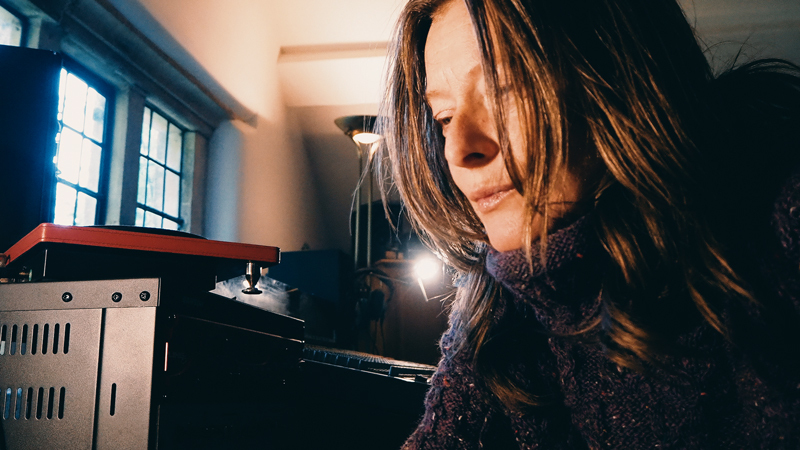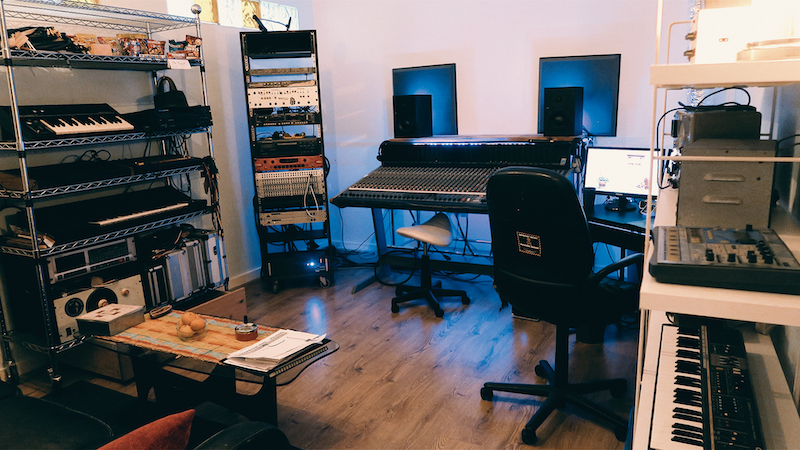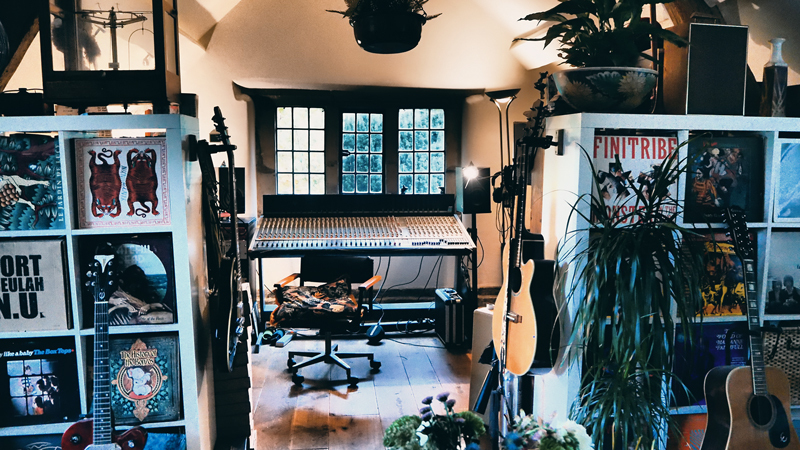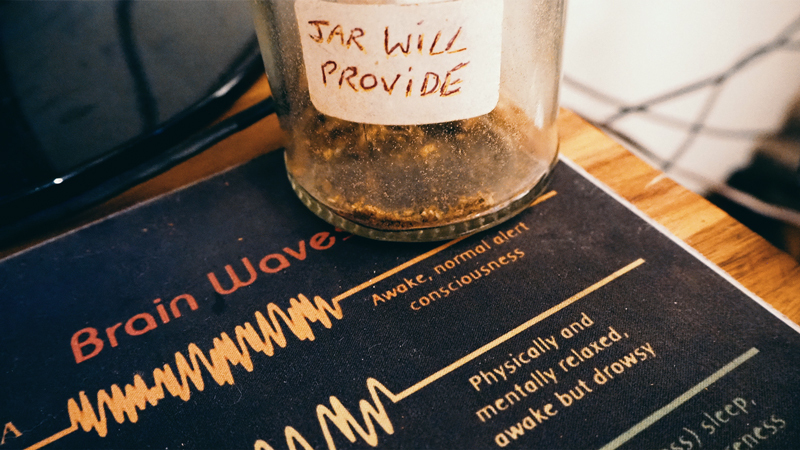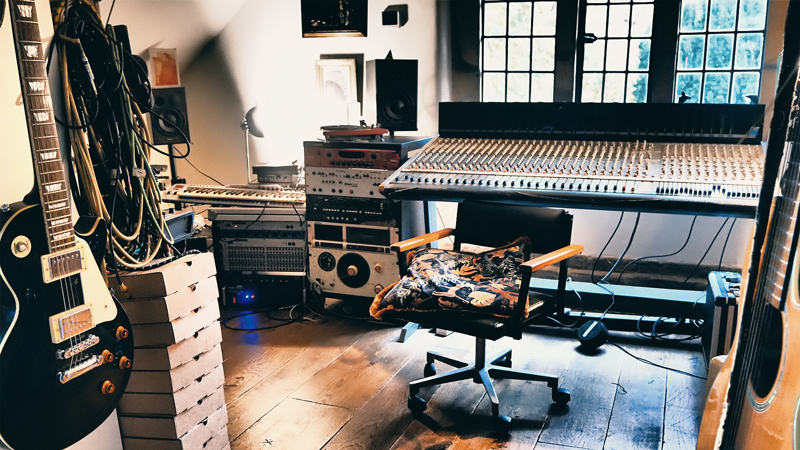Blog
Nina Walsh Presents the Lab Report from Facility 4
2 Feb '2023
The singer, songwriter and electronica investigator Nina Walsh returns with a collection of sonic experiments from her Facility 4 studio

You can track Nina Walsh’s life as an artist through the sonic spaces or “research facilities” that she has called home at one time or another. Facility 1 was a flat in London’s Woodleigh Gardens; Facility 2, a spot in Westcote Studios that Nina held for eight years; Facility 3, a shed in the back garden of Killing Joke bassist Youth’s South London abode and Facility 4, purpose built into a converted stable located in an old Dickensian alleyway in Streatham.
In each space, Nina has doggedly pursued her relentless musical quest experimenting with musical genres and sounds, often side by side with long-standing co-conspirator, the late great Andrew Weatherall, who produced her first ever commercially recorded vocal on a Primal Scream remix, igniting the creative relationship that continued onstage or in the studio until his sad passing in 2020.
Throughout her journey Nina has started record labels releasing diverse styles of electronic music straddling techno, folk and experimental, written music for film and globally successful BBC TV series Killing Eve, created literary soundscapes, released solo, duo and group projects, and done all of it with innate sense of melody, musical expertise and studio skills.
Lab Report 2 is Nina Walsh’s first solo sample pack, following on from Andrew Weatherall & Nina Walsh Woodleigh Research Facility, an experimental collection of otherworldly recordings and abstract sounds. The new pack continues the sonic investigations of Facility 4, delivering a fresh arsenal of synth sounds, vocal loops, bass, textural FX and further vital ingredients useful in the creation of electronically based music.
As an artist, what was the experience like for you to create a resource for other artists?
I always used to dream of being paid to sit there and make silly noises all day. The symbiosis between Andrew and I was that I was mixing the paints for his palette, and he was creating the picture. I was the musician, he was the DJ. I was also the tech, and I’ve never been keen on people sitting idle in the studio, so my mission was always to get Andrew in front of a computer.
The idea was to give him more control so that he wasn’t always relying on me. I would basically feed him, which is what I’m now doing for anyone who buys this sample pack. They can paint the picture with it, and process it or put it in any order they like.
With such different styles of working, how did you go about creating an environment that suited both of you?
What Andrew was so good at, because he was out DJing every weekend, was telling the story of those few days. On Monday, we’d sit and drink coffee, smoke Woodbines, read the newspaper and discuss his weekend. I set up two rooms; a programming room specifically for Andrew and the main control room, which is where I would mostly work. The programming room had a computer with some funky software that wasn’t too technically challenging for him once he got a taste for it and provided the necessary tools for the job.
There were other moments like when Andy Bell came in to buy a Vox Invader guitar from Andrew. I just stuck it into record while he was testing the guitar in the main control room, where the big guns came into play. I would never push a DAW on Andrew though, it would have been silly to bombard him with too much tech. Usually, he’d be chiseling away at one end of the studio and I’d be doing the same at the other. We would then join forces in the main room to overdub any musicians and finish the mix.
Were your individual roles always clearly defined in that sense, or were things quite malleable?
Pretty much, apart from the songwriting side where we’d sit and I’d play the guitar and we’d find the melody together. Andrew would have his little black notebook with lots of scribbles, and as soon as he’d go quiet I knew he was on a roll. I’d keep flying things in and, by the end of the day, the song would be 90% structured. The following day we would go into the live room and record some vocals.
Often I would go in and add harmonies to Andrew’s vocals., He would then want to go back in and re-record his because I’d have found some slightly more buoyant melody. Then I would have to go back in and redo my harmonies around his new ones!
Do all the sounds in the sample pack come from these sessions?
They’re pretty much all from that period, yes. After the first pack, Lab Report One, which helped to finance the building of Facility 4 studio, I started a Loopmasters 2 folder which contained all of my loops and musings. All of the subfolders were organised by the date and the piece that we were working on at the time, as well as the music that I was creating just because that’s what I do. When it came time to do this pack, I was able to go back into the folder and sort everything out.
There are a lot of interesting synth sounds in the pack, did you mainly use software or hardware for those?
Both. Korgs and Yamaha CS30 are my favourites on the synth front, but sometimes they would be soft synths and sometimes hardware. I would often process the FM sounds so that they sounded like they were a Moog. Some of the sounds aren’t even synths at all, they were made using my voice, flutes, or even the squeaky doors of the recording studio.
The name of your studio suggests that it was very much a place of musical experimentation. Has that always been important to you in your career?
I used to have a seven-inch label called C-pij, which was pretty much all about me learning electronics and how to use the studio, which was in Woodleigh Gardens. It was very experimental; I had test tubes lit up across the fireplace and we would wear white lab coats, so it really felt like research.
Then I started working with binaural sounds, and more alternative things like Electronic Voice Phenomena. Andrew and I would have these little YouTube sessions where we’d watch videos recording voices from the ether. I ended up working on those pieces with hypnotherapists and using the compositions for inducing altered states of consciousness. That’s something I’ve always been intrigued by.
You have a unique ability to weave these alternative sonic elements in with a traditional songwriting foundation, where does that come from?
I started playing Spanish classical guitar when I was eight and soon after began composing my own songs and performing them at school concerts. I later met Andrew and expanded my musical education by listening to his record collection and on the dance floor at clubs. I guess it was a natural evolution that has steered my life for so long. My first job was working for London Records / FFRR in club promotions before starting the Sabres Of Paradise and Sabrettes record labels with Andrew and releasing music. It’s just in my blood.
I’m someone who has to have a melody, and I get very bored if it’s too linear. If you listen to my songs, you’ll hear strange key changes, which I write without even really knowing what I’m doing. I’m not trying to do jazz, and I’m not really interested in what key we’re playing in – I leave that to the real musicians!
Having been a lifelong collaborator in music, what would you say you’ve learned most from your relationships with other musicians?
It’s all about playing to each other’s strengths and having very strong mutual respect. Andrew was amazing at arranging dancefloor belters; much better than me, so I would hand that straight over to him. Collaborations fail where there’s a power struggle going on, or an ego trip. That can’t happen in the studio because the flow will just be completely blocked. I’ve had to walk away from certain projects because of those situations.
I’m largely self-taught as a musician and producer, but the whole reason I went to college to study sound engineering was that I was being blocked by sound engineers not taking on board my suggestions. You can’t do everything as an artist, you do have to delegate, but you can get the right team or partnership together and create that energy in the studio where you’re all bouncing off each other and it’s really fun.
How would you like to see the sample pack being used by producers?
The further through the mangle the better! It’s really down to the person, but I’d love to hear it processed even more so that it’s unrecognisable. Get creative with it and use it as a songwriting tool to create your own songs. Embrace the melodies, steal them, sing them, or play them on a Theremin – they’re there for the taking.
The most inspiring part of all this for me is that it keeps the beautiful creative energy that Andrew and I surrounded ourselves with at Facility 4 alive. The sounds in this sample pack are little audio seeds that plant new life elsewhere.
